- Bernard Preston homepage
- Beekeeping
- Why Does Honey Crystallise
Why does honey crystallise?
Why does honey crystallise says that a fine set is a sign of quality.
Honey is a supersaturated solution of mainly two sugars, namely fructose and glucose, in water. Crystallization is a perfectly natural-process and certainly not a sign that the honey has gone off. Don't throw it away.
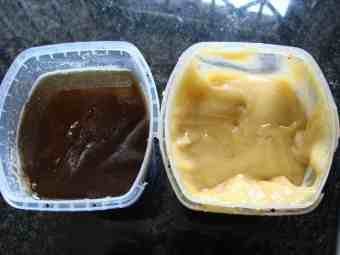 Two months later.
Two months later.This page was updated by Dr Bernard Preston on 8th July, 2021.
In fact, if your runny honey has crystallized, forming fine, uniform crystals, then it's a sign of a good, unspoiled-food.
You see, honey is a very heat labile product; more about that later, but for the moment grasp the important fact that most of the stuff on the supermarket-shelves has been spoiled by heating. It's a euphemism to say it's been warmed; at the contact point it is heated.
Why is it heated, you may well ask? There are several reasons but the most significant is that the consumer, you, likes it that way. It looks better perhaps and the public has the mistaken conception that runny-honey is purer and more natural. That is not so; in fact quite the opposite is usually true.
The honey from certain plants like acacias, the black locust and cranberries crystallise very slowly or not at all; jacarandas and citrus too. More about why that is later, but from those plants runny-honey is perfectly normal and good.
Why does honey crystallise?
Why does honey crystallise, and is it okay to eat? In fact it's probably purer and better.
For the rest however, if your honey doesn't set, then it's probably been heated too much. The main source of South African honey is the eucalypt tree and it crystallizes very quickly; within weeks. So, if you find, runny honey on the shelves of your supermarket, then you know it's been processed; and, to the purist, spoiled.
Choose a crystallised honey any day over its runny compatriot; there are exceptions like citrus and jacaranda. But do choose one that has formed nice fine and uniform crystals. If they are large and irregular, and in particular if they settle out at the bottom, then you know the food processing industry has got hold of it, and ruined the honey.
Be prepared to pay more for a nicely set honey; it's the real thing. Or think about how to start beekeeping if you want the best honey; it's less difficult than you think.
There are three main ingredients in honey, and then some very important substances, albeit in small quantities.
- Fructose
- Glucose
- Water
Natural honey, as it comes from the bee hive contains about 40 percent fructose, 30 percent glucose and just less than 20 percent water. That means that it's a highly concentrated solution of sugars; in short, it's super saturated and has more sugar in solution than that amount of water could normally dissolve. That's the main answer to the question why does honey crystallise.
The bees keep it runny in the hive by maintaining the temperature around a warm 35 degrees; nectar from the flowers is much more dilute than that so, during the honey flow, they raise the temperature to around 40*C, and you'll see them fanning at the entrance to the hive to evaporate off the excess water.
Why does honey crystallise in the hive, is another question; those with a higher glucose fraction will set during a cold winter right in the comb. From a management point of view it's best to harvest almost all the liquid honey, leaving just enough for them to survive, depending on how cold and long the dearth period is. If it sets in the comb it's almost impossible to get it out.
Examining your colonies periodically is important to establish that you've left them enough; otherwise they may starve.
Honey should never be heated over 40 degrees. Do not microwave it and definitely do not put it in a pot of hot water, as is often recommended; you'll ruin it.
More later about how to make your set honey runny again.
So, here's the deal; as a rule of thumb, crystallized honey is better than the runny-stuff, though this is not always the case; creamed even better still.
It's really interesting; the mind is a very complex organ and it can be retrained. Just start saying to yourself when shopping for pure, natural honey that this, the crystallized form, is better for me. It's unspoiled by processing.
Within just a few short weeks, you'll
discover that runny honey isn't as nice after all; it doesn't taste as good and it's a lot more
messy too; more important, not as good for you.
In fact, I prefer crystallised honey because it doesn't run off the toast down to your elbows, like watermelon juice, and onto the plate; also it actually tastes and smells finer too. Those tantalizing flower fragrances that makes for a natural, raw product are much better in the unheated state. Warming drives off many of those finer scents.
Why does honey crystallise? It's all about the ratio of those three main ingredients; fructose, sucrose and water.
Fructose is the largest fraction, ranging from 30 to 44 percent of natural honey, depending on which flowers the bees have been feeding. It's the sugar that makes fruit so sweet; it's a so called simple sugar and is rapidly absorbed into the blood stream for energy. Fructose is very soluble in water.
Glucose is the second highest fraction in honey from the hive. It varies too according to the flower; from 25 to 40 percent. It's a simple sugar also, but it's less soluble than fructose. Why does honey crystallise? It's the glucose that crystallizes out.
Plants have the amazing capacity, using chlorophyll, to capture the energy of the sun and turn it into the stored chemical energy in substances like glucose and fructose. These two sugars are the basis of much of the energy our bodies need.
Water is the third most common ingredient in honey; it's present at around 17 percent.
That's very little really, making honey an over saturated solution. Then, when the temperature cools from the 35 degrees in the hive to the 20 odd degrees on your shelf, the glucose starts changing into tiny, uniform crystals if it hasn't been processed.
What you'll notice is that your honey starts to thicken and go cloudy, and the colour will lighten as the glucose crystals are white in nature. This is a perfectly natural and normal process; it's the sign of a high quality product and not one that's spoiling.
Are you starting to grasp why honey crystallizes? It's not that complicated.
What determines how quickly your natural honey will set is controlled by several factors. The most important is the ratio of glucose to fructose. Remember that it's the former that is crystallising out.
If the concentration of glucose is higher, then the honey will set faster. If there's much more fructose, then it crystallises more slowly, or not at all. It's all determined by the source of the nectar; it's the flower and not the bee that will determine whether it sets or not.
Some honeys have more or less than the standard 17 percent water, so this too will affect the rate of crystallization.
As the nectar in the cells in the hive is concentrated by the fanning of the bees, water is driven off, and the novice beekeeper may be surprised to find droplets of water condensing out on the lid, and think that rain must be getting in. That in fact is not the case; it's the moisture driven off from the nectar that is condensing out on the cooler lid. That's why a hive should tilt slightly forwards so that this water will run out.
Then, when the water concentration is down near 17 percent, the bees will cap the cell to keep air out, and so they don't get their feet sticky!
Ideally, the good beekeeper takes only frames that are fully capped. Then you know the honey is ripe, the correct amount of water has been removed and the solution is so saturated that bugs cannot survive in the honey. The honey literally sucks the water out of them, destroying them.
The bad beekeeper, either from ignorance or greed, harvests honey that is not yet ripe. There's still too much water and it's possible that some bacteria may be able to survive in the honey.
So, why does honey crystallise? It's a perfectly natural process determined by the ratio of frustose to glucose, and the amount of water in the honey. Immature honey will form large ugly, non uniform crystals that will settle at the bottom of the jar. Avoid like the plague! And never buy from that beekeeper again.
Pollen in honey
There has been an important shift in the preparation of honey. In the early days, it had to be "pure". The honey was filtered through multiple layers of gauze or muslin; today we are recommending local pollen in honey. It also helps to answer the question why does honey crystallise; you get a finer set.
Research has shown that raw honey, rich in the pollen granules from your area, will help with sinusitis and asthma, if you are allergic to those pollens. Buy your honey from a local beekeeper if you want that benefit. Better still, many people are finding out how to start beekeeping. You could too!
When honey is extracted from the honey combs, plenty of pollen comes out with the honey. So, now the trend is only to pass the honey through a coarse strainer to remove dead bees and bits of wax. The pollen must stay in suspension in the honey.
The honey is then left for several days in a settling tank for the air bubbles and any foreign matter to rise to the surface where it can be scraped off.
This is yet another reason why does honey crystallise. These pollen granules become tiny nuclei for seed crystals of glucose to set on. Unstrained it will set faster, and more uniformly. It's a sign of a better product.
Why does honey crystallise? You will gather from all this, that the production of a healthy, good honey is determined by many factors. Not least of which, unscrupulous beekeepers and honey processing companies can adulterate the honey, heat it, and do all sorts to give the public want they want; pure, visually clear runny honey. In short, a less tasty, and less healthy product. But you know better, right?
Now we cream it to satisfy those vexed by the question of why does honey crystallise, making it hard and more difficult to spread on your toast.
Week 1
We'll follow the crystallising process over the next few weeks. This is week 1 after harvesting. A close up look shows that tiny crystals are already forming, and the honey is going cloudy.
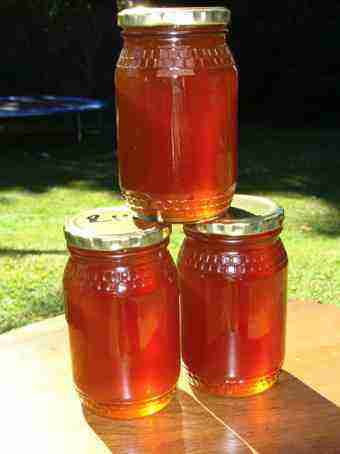
Here are the same bottles of raw honey three weeks later.
Why does honey crystallise?
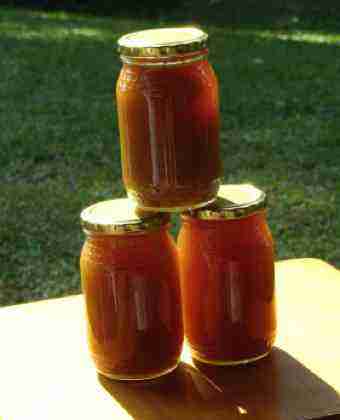
A close up at week 4 shows the fine, smooth crystals forming. This is good, natural honey, unspoiled by heat.
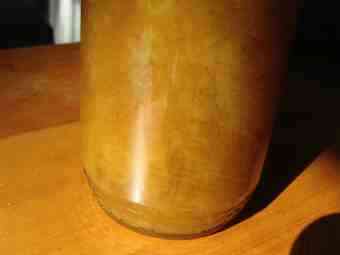
Liquidise crystallised honey
For one reason or another you may want to liquidise crystallised honey. Do not microwave it, or place it in a saucepan of hot water. You'll spoil your lovely raw honey.
Instead, place it in a thin-walled shoebox, and place the box on a sunny windowsill. If necessary cover it with a black cloth. Be patient and give it time.
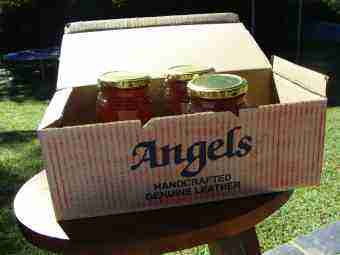
If you need liquid honey now, then rather heat your supermarket honey in hot water, not your special raw honey.
Old pollen
Old pollen in the combs is often infected with fungi. The bees don't relish it so it may contaminate the honey; it can stay there for years.
This old pollen as it builds up takes up valuable space in the brood nest where the queen may be wanting to lay her eggs. It can also act as a seed answering in part the question why does honey crystallise.
Crystallised honey in the comb is a real problem for the beekeeper; again the bees don't tend to use it unless they there is a dearth so it can build up, taking up space.
For obvious reasons beekeepers tend to leave some honey for the bees; however, should it crystallise it becomes highly problematic.
Good management should include taking all the honey in the supers and then feeding some of it back to the bees should there be signs of hunger. That would include removing at least two of the outer combs every year particularly if there is old pollen or crystallised nectar; replace with new sheets of foundation.
Creamed honey
Creamed honey comes in two forms; that which is whipped for a long period, an hour or more, incorporating a lot of air in the liquid. You'll find that a bottle weighs considerably less than the standard jar, making its price per gram higher.
The second which I advocate is to seed the liquid with a high quality, fine crystal honey; about 10%. In fact previously creamed honey is perfect for this process.
The seeded honey is then whipped for a short time, just a few minutes to distribute the seeds throughout the liquid; it's still very fluid and must be bottled immediately, otherwise it will crystallise in a short time in the drum.
Both methods work, producing a creamed honey that has very fine crystals and does not harden; it has the consistency of peanut butter and is easy to spread, but doesn't run off your toast and down your to your elbows like watermelon juice! Use these simple natural techniques to improve the quality without comprising the goodness.
There's no change in the taste and, whilst it is processed, it contains all the nutrients of the original.
The first method, which I don't advocate, would incorporate a lot of air in the liquid, perhaps contributing to oxidation.
In answer to why does honey crystallise, it just giving it a multitude of tiny seeds to form a very smooth and pleasant consistency.
My clients love it, and I'm looking to cream most of my honey these days.
Read about how you could make creamed clover honey at home for a fraction of the price.
How to start beekeeping
Like starting anything new, start scouring the net for information; it's loaded with the lore of how to start beekeeping. Next, I would recommend you join a local association. You will avoid many of the common errors. It is not rocket science to have a honey beehive at the bottom of your garden and may be one of the most rewarding things you could do this year. It has been the enduring hobby of a lifetime for me. Initially, why does honey crystallise may not seem important to you; later it will be.
You can expect an average hive to produce about 20 to 70 one-pound jars of honey every year. If you're serious then how to start beekeeping may be for you.
You must drill holes in the used geyser tray otherwise the bees will drown in the rainwater.
I would recommend that you start with the wonder of natural honeycomb and only later start thinking about an extractor.
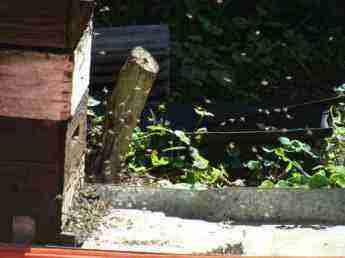
So who will save the bees? Whether it's the same toxic pesticides that are killing us, loss of habitat or adulteration of honey the result is the same. The insects that pollinate our food are dying off at an alarming rate.
Why do we only eat new potatoes from our green garden?
- Beekeeping Equipment ...
- Waxing Honeybee frames ...
- Honey bee traps ... catch your own.
- Making soft set honey
- Swarming bees
When browsing use right click and Open Link in New Tab, or you may get a bad gateway signal.
Bernard Preston's books
I've enjoyed writing these blogs about beekeeping and why does honey crystallise, gliding and gardening nearly as much as my other books from the coalface; they are my real passion. Each of them took five years to write and edit; you too can enjoy these Bernard Preston books.
Frog in my Throat is only available in paperback presently, but you can enjoy Bats in my Belfry and Stones in my Clog on your Kindle or tablet. Not more long boring hours standing in queues or sitting on trains and planes. Get you teeth into these delicious stories. Free tidbits are available at their home pages in the navigation bar.
For the more adventurous, be prepared to have your feathers ruffled in A Family Affair; a novel with a wicked twist.
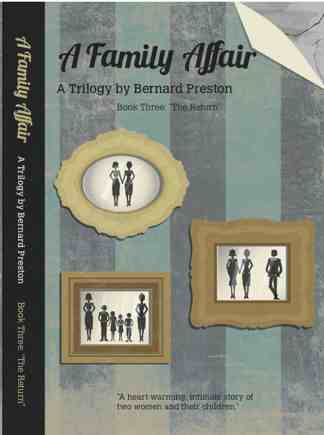
The greed factor has set in with many ebooks; they cost even more than paperbacks despite zero overheads and no highstreet store costs. But I keep the price of my ebooks down for you. Just see...
Have you read my latest trilogy? Only $1.14 each. Hold onto your hat. Find A Family Affair by Bernard Preston at Amazon.
You can sample Book I, The Bostonians, at this link: Jan Jansen
Newsletter
Our newsletter is entitled "create a cyan zone" at your home, preserving both yourself and Mother Earth for future generations; and the family too, of course. We promise not to spam you with daily emails promoting various products. You may get an occasional nudge to buy one of my books.
Here are the back issues.
- Lifestyle and ideal body weight
- What are ultra-processed foods?
- Investing in long-term health
- Diseases from plastic exposure
- Intensive lifestyle management for obesity has limited value
- A world largely devoid of Parkinson's Disease
- The impact of friendly bacteria in the tum on the prevention of cancer
- There's a hole in the bucket
- Everyone is talking about weight loss drugs
- Pull the sweet tooth
- If you suffer from heartburn plant a susu
- Refined maize meal and stunting
- Should agriculture and industry get priority for water and electricity?
- Nature is calling
- Mill your own flour
- Bake your own sourdough bread
- Microplastics from our water
- Alternative types of water storage
- Wear your clothes out
- Comfort foods
- Create a bee-friendly environment
- Go to bed slightly hungry
- Keep bees
- Blue zone folk are religious
- Reduce plastic waste
- Family is important
- What can go in compost?
- Grow broad beans for longevity
- Harvest and store sunshine
- Blue zone exercise
- Harvest and store your rainwater
- Create a cyan zone at your home
Useful links
Did you find this page interesting? How about forwarding it to a friendly book or food junkie? Better still, a social media tick would help.
- Bernard Preston homepage
- Beekeeping
- Why Does Honey Crystallise
Address:
56 Groenekloof Rd,
Hilton, KZN
South Africa
Website:
https://www.bernard-preston.com